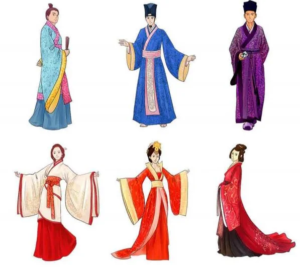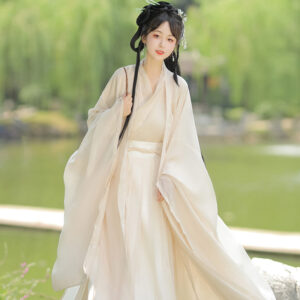
The Tang Dynasty (618–907 CE) was a period of prosperity, cultural flourishing, and openness to foreign influences, which all had a profound impact on the evolution of Hanfu, the traditional clothing of the Han Chinese. Hanfu during the Tang Dynasty is often regarded as one of the most elegant and vibrant forms of traditional Chinese clothing, known for its beauty, luxurious materials, and bold designs. The key features of Tang Dynasty Hanfu include its variety in styles, vibrant colors, and incorporation of elements from foreign cultures.
Here are the key features of Hanfu during the Tang Dynasty:
1. Bold and Vibrant Colors
The Tang Dynasty was a time of wealth and cultural exchange, and this was reflected in the clothing, which featured rich and vibrant colors.
- Colors for Women: Women’s Hanfu often included bold hues such as red, yellow, gold, and bright blue. Red, in particular, was highly popular, symbolizing wealth, vitality, and joy.
- Colors for Men: Men’s Hanfu typically included darker colors like black, brown, and dark blue, though more decorative and colorful robes were worn for formal occasions.
2. High-Waisted Skirts (Qixiong Ruqun, 齐胸襦裙)
One of the most iconic features of Tang Dynasty women’s fashion was the Qixiong Ruqun, which is a high-waisted skirt that was tied just below the chest, creating a long, flowing silhouette.
- Structure: This ensemble typically consisted of a short blouse (Ru) paired with a long, flowing skirt (Qun). The high waistline created an elegant and graceful appearance, often making the wearer look taller and more slender.
- Outer Garments: Women would often wear a transparent silk shawl or outer robe over the Qixiong Ruqun for added layers, which created a more ethereal look.
3. Large Sleeved Robes (Daxiushan, 大袖衫)
The Daxiushan, or large-sleeved robe, was a popular outer garment worn by women, particularly during formal events or ceremonies. These robes were known for their extravagantly wide sleeves, which gave a dramatic and flowing appearance when in motion.
- Material and Design: These robes were made of luxurious materials like silk, often with intricate embroidery featuring flowers, birds, and other symbolic motifs.
- Elegance and Status: The larger and wider the sleeves, the more formal the attire, making the Daxiushan a symbol of nobility and elegance. Nobles and high-ranking women wore these robes during important occasions.
4. Tight-Fitting Bodices
In contrast to the flowing skirts and robes, the bodices of women’s Hanfu during the Tang Dynasty were more form-fitting, accentuating the natural curves of the body.
- Design: The blouse (Ru) was often short and tight, with a V-neck or a low collar. Sometimes, women wore sleeveless or very short-sleeved tops underneath outer layers, allowing them to show off their slim figures.
5. Influence of Foreign Cultures
The Tang Dynasty was an era of openness and cosmopolitanism, welcoming influences from countries along the Silk Road such as Persia, Central Asia, and India. These cultural exchanges were reflected in the designs and patterns of Hanfu.
- Exotic Elements: Some Tang Dynasty garments featured foreign elements, such as round-collared robes (often inspired by Central Asian styles), and exotic patterns like flowers, birds, and mythical creatures that were popular in foreign art.
- Fabrics and Textiles: Imported materials like brocade, satin, and intricate textiles became popular during the Tang Dynasty, elevating the luxury and variety of fabrics available for Hanfu.
6. Round-Collared Robes (Yuanling Pao, 圆领袍)
While the high-waisted skirts and wide-sleeved robes were more common for women, men of the Tang Dynasty favored the Yuanling Pao, or round-collared robe. This type of Hanfu was more fitted and practical compared to earlier styles.
- For Men: The Yuanling Pao was a long robe with a round collar, often tied with a belt. It was typically worn by scholars, officials, and the upper class.
- For Women: Some women, particularly those of the upper classes or in more formal settings, also adopted the round-collared robe, although they often layered it with other garments like skirts or shawls for a more feminine touch.
7. Intricate Embroidery and Patterns
During the Tang Dynasty, embroidery became a hallmark of luxury and status in Hanfu. The wealthy and noble classes often wore garments adorned with intricate embroidery, which symbolized wealth, status, and good fortune.
- Motifs: Popular motifs included flowers, birds, dragons, and phoenixes, each with their own symbolic meanings. Dragons, for example, were associated with imperial power, while phoenixes represented grace and virtue.
- Materials: Embroidery was typically done in gold and silver thread on fine silk, further emphasizing the grandeur of the clothing.
8. Hair and Accessories
Hair and accessories played an important role in complementing the elegant styles of Tang Dynasty Hanfu. Both men and women styled their hair in elaborate ways and adorned it with beautiful accessories.
- Hair for Women: Women styled their hair in intricate, voluminous updos, often using hairpins, combs, and ribbons to hold the styles in place. Jade and gold hairpins were common for nobility.
- Headdresses: For formal occasions, high-ranking women wore elaborate headdresses such as the Fengguan (phoenix crown), which was encrusted with pearls and precious stones.
- Fans and Jewelry: Fans were both practical and decorative, often made of silk and featuring intricate designs. Women also wore jade or pearl necklaces, earrings, and bracelets to complement their attire.
9. Shoes and Footwear
Footwear in the Tang Dynasty was designed to complement the elegant attire. Both men and women wore finely crafted shoes, often made from silk or leather.
- Women’s Shoes: Women’s shoes were typically embroidered cloth shoes with soft soles, often featuring designs of flowers or auspicious symbols. Platform shoes (高底鞋) were also worn to elevate the wearer’s height, especially among the upper class.
- Men’s Shoes: Men wore more practical shoes made of leather or woven cloth, but high-ranking officials often wore embroidered shoes as a mark of status.
10. Social and Gender Influence on Styles
Hanfu styles during the Tang Dynasty varied based on the wearer’s gender, social class, and occupation.
- Gender Differences: Women’s Hanfu was more colorful, elaborate, and decorative, while men’s clothing was more restrained, reflecting their roles in society. However, both genders could wear elaborate outfits for formal occasions.
- Class Differences: Nobility and officials wore the most extravagant Hanfu with luxurious materials and intricate embroidery, while commoners wore simpler, plainer styles. However, even among the commoners, there was a focus on grace and fluidity in design.
Conclusion: The Tang Dynasty’s Lasting Influence on Hanfu
The Hanfu styles of the Tang Dynasty were marked by a blend of elegance, luxury, and a cosmopolitan flair, reflecting the empire’s wealth and cultural openness. Bold colors, flowing fabrics, high-waisted skirts, wide-sleeved robes, and intricate accessories all combined to create a style that has continued to inspire fashion in China today. The Tang Dynasty’s Hanfu is often celebrated as one of the most beautiful and sophisticated forms of traditional Chinese clothing.
Share this post
Recent Posts


What were the key features of Hanfu during the Tang Dynasty?

How did Hanfu styles vary during different Chinese dynasties?

What accessories are typically worn with Hanfu?

How do you choose the right Hanfu for different seasons?

Newsletter
Popular Categories
Related Post
Sed aliquam, tortor et sodales malesuada, lorem leo luctus tellus, quis interdum eros nibh in nunc. Cras dignissim malesuada, lorem leo luctus

What are the winter hanfu called?

What were the key features of Hanfu during the Tang Dynasty?

How did Hanfu styles vary during different Chinese dynasties?


